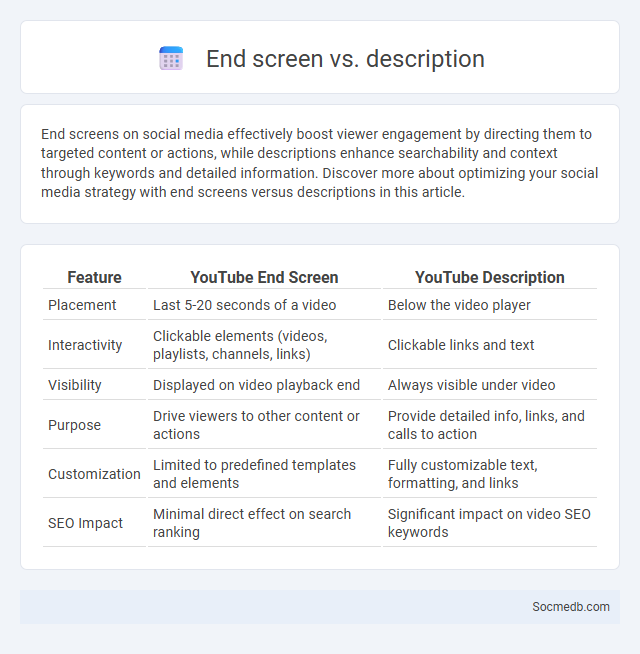
Photo illustration: end screen vs description
End screens on social media effectively boost viewer engagement by directing them to targeted content or actions, while descriptions enhance searchability and context through keywords and detailed information. Discover more about optimizing your social media strategy with end screens versus descriptions in this article.
Table of Comparison
| Feature | YouTube End Screen | YouTube Description |
|---|---|---|
| Placement | Last 5-20 seconds of a video | Below the video player |
| Interactivity | Clickable elements (videos, playlists, channels, links) | Clickable links and text |
| Visibility | Displayed on video playback end | Always visible under video |
| Purpose | Drive viewers to other content or actions | Provide detailed info, links, and calls to action |
| Customization | Limited to predefined templates and elements | Fully customizable text, formatting, and links |
| SEO Impact | Minimal direct effect on search ranking | Significant impact on video SEO keywords |
Understanding End Screens: Key Features and Benefits
End screens on social media platforms, such as YouTube, offer interactive elements like video recommendations, subscribe buttons, and external links to boost viewer engagement and channel growth. These features enhance your content's discoverability and encourage audience retention by directing viewers to related videos or encouraging subscriptions. Leveraging end screens effectively can significantly increase your channel's reach and viewer interaction, driving long-term success.
Role of Video Descriptions in Viewer Engagement
Video descriptions enhance viewer engagement by providing context, improving accessibility, and boosting search engine optimization on social media platforms. Clear and keyword-rich descriptions help You attract relevant audiences, increase video visibility, and encourage interactions such as likes, comments, and shares. Crafting compelling descriptions tailored to your content ensures better audience understanding and retention.
What Is Metadata and Why Does It Matter?
Metadata on social media consists of data about your posts, such as timestamp, location, device type, and user interactions, which influences content visibility and targeting. This information helps platforms like Facebook and Instagram tailor algorithms to enhance user engagement and deliver more relevant ads. Understanding metadata empowers you to optimize your content strategy and protect your privacy online.
End Screen vs Description: Impact on Click-Through Rate
End screens and video descriptions play crucial roles in driving click-through rates (CTR) on social media platforms, with end screens offering visual prompts that capture viewer attention at the video's conclusion. Your CTR can be significantly boosted by optimizing end screens with clear, compelling calls-to-action, while detailed descriptions improve searchability and provide context that encourages viewers to click through links. Balancing both elements strategically ensures maximum engagement and increases the likelihood of conversions on your content.
How Metadata Shapes Search Discoverability
Metadata plays a crucial role in shaping search discoverability on social media by providing structured information about posts, including keywords, hashtags, timestamps, and geotags. These data points enable algorithms to categorize content accurately, improving relevance in user search queries and personalized recommendations. Optimizing metadata enhances visibility by aligning social media content with user intent and platform indexing mechanisms.
Best Practices for Optimizing End Screens
Optimizing end screens on social media videos involves incorporating clear calls to action and visually compelling elements that encourage viewers to engage further. You should strategically place clickable elements like subscribe buttons, video links, or playlists within the last 5-20 seconds to maximize viewer interaction. Consistently analyzing performance metrics and testing different end screen layouts help enhance user retention and boost overall channel growth.
Crafting Compelling Video Descriptions for SEO
Crafting compelling video descriptions for SEO involves incorporating relevant keywords that match your target audience's search intent, enhancing your video's visibility on platforms like YouTube and Google. Your descriptions should clearly summarize the video's content, include timestamps, and provide links to related resources to increase viewer engagement and session duration. Optimizing these elements helps search engines accurately index your content, driving more organic traffic and boosting your video's ranking.
Metadata Optimization Techniques for Maximum Reach
Metadata optimization techniques for social media include using targeted keywords in titles, descriptions, and tags to improve content discoverability on platforms like Instagram, Facebook, and LinkedIn. Implementing structured data such as Open Graph tags and Twitter Cards enhances how posts are displayed in feeds, increasing engagement and click-through rates. Consistent updating of metadata based on analytics ensures alignment with trending topics and audience preferences, maximizing reach and visibility.
Comparing Conversion Rates: End Screen, Description, & Metadata
Comparing conversion rates across social media platforms reveals that end screens typically yield higher engagement than descriptions and metadata due to their visual and interactive nature. Metadata, while crucial for search optimization, often drives less immediate action compared to the direct calls-to-action in end screens. Your strategy should prioritize optimizing end screens while ensuring descriptive text and metadata accurately support content discoverability.
Integrated Strategies: Maximizing YouTube Performance with All Three
Maximizing YouTube performance requires integrated strategies that combine content optimization, audience engagement, and cross-platform promotion. Utilizing SEO techniques such as keyword-rich titles, detailed descriptions, and relevant tags enhances visibility, while consistent interaction through comments and live sessions fosters community loyalty. Leveraging other social media platforms like Instagram, Twitter, and Facebook amplifies reach and drives traffic to YouTube channels, creating a cohesive digital presence that boosts overall growth.
 socmedb.com
socmedb.com